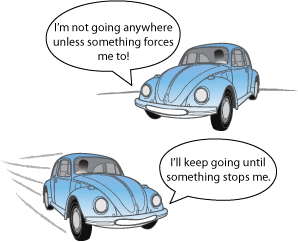
Laws
of
MOTION

The Laws of Motion are the base for basic mechanics and how things move in our world. Sir Isaac Newton defined the Laws of Motion and laid out these laws in his Philosophiae Naturalis Principia Mathematica, which was published in 1687. This book also laid out the Law of Universal Gravitation. There are three Laws of Motion.The first Law of Motion states that an object will remain in the state of motion it’s in unless an external force acts on it. This is known as the Law of Inertia. The second law tells us how much force is required to move an object with a certain mass at a particular speed (Force= Mass x Acceleration). Last but not least, the third law states that for every action, there is an equal and opposite reaction. The Laws of Motion affect everything in our lives, and can be applied to almost anything to find the force needed, how far something will go, or what will happen because of how something moved.
The three laws of motion
The first law of motion states that an object will keep its state of motion unless acted upon by an outside source. This is otherwise known as the Law of Inertia. This means that without the pull of gravity or air resistance and a number of other factors, an object would continue to move in any direction and not stop. An object will remain at a constant speed in a straight line unless acted upon by an outside force. An example of this is a gyroscope, which is basically a disc mounted on an axis that can spin freely, or a washing machine.



The second Law of Motion tells us that Force= Mass x Acceleration. This means that there is a certain amount of force needed to push an object with a particular weight at a specific speed. This can help us in many ways, including how much thrust is needed to lift a rocket into space or how much force is needed to move a car.

The third law states that for every action, there is an equal and opposite reaction. This basically means that for a rocket to move up, something must be pushed towards the ground. This is one example of this law. Another example is how a squid or an octopus push their tentacles back so they can move forward.



